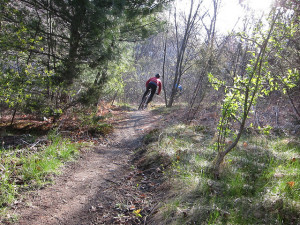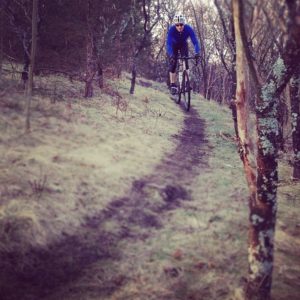We’ve already talked about Going Up, Going Far and Going Fast. Going to the Woods is another thing we like to do, riding the jeep tracks and trails that crisscross our New England forests. We design bikes to go there in a few different ways.
Two crucial variables for any woods-oriented bikes are traction and speed. How will we keep the wheels on the ground, and how fast do we want them to move? Suspension is an option with our classic NE hardtail mountain bikes, the Solas and 622M SLX. They’re built to be fast over chattery, heavily-rooted ground and to climb the short, steep pitches we find all over. The Ti chainstays on these bikes act as de facto suspension systems, effectively keep the rear tire planted on the ground and rolling forward. For dirt road bikes, we can narrow the tires and build around a rigid fork, which will speed things up on less technical terrain.
Another key question is, how much ground are we trying to cover? Are typical rides of approximately the same length, as with a cross country race bike, or do they vary wildly, with marathon trail sessions coming as often as possible. Those two bikes differ geometrically, one built for agility and speed, the other for comfort and stability. We can build them as traditional trail bikes, or with rack mounts for bike-packing. Geometries can get more relaxed or more aggressive.
We also send our Evergreens and Expats to the trees. The Evergreens are designed to tackle mixed-terrain, some road, some dirt. The Expats are touring bikes. As with the other types of bikes we design, finding the balance points is key to delivering the right bike. Going to the Woods can add as many or more different variables than the bikes we’ve discussed in previous pieces, so working through all the basic questions is integral to the process.


